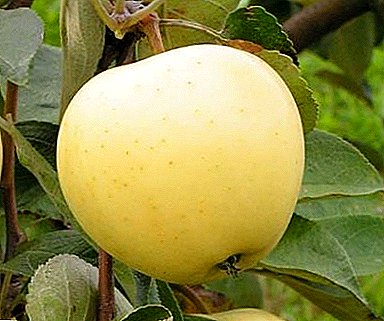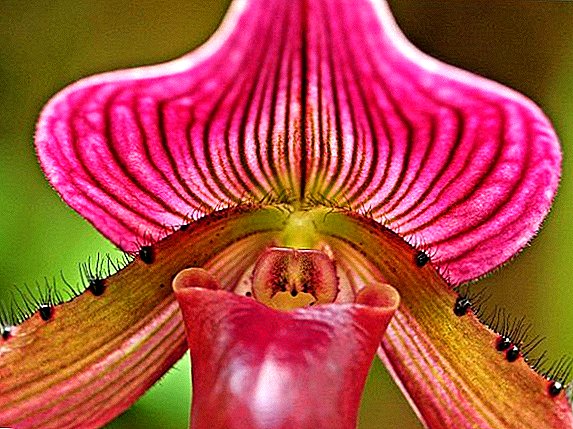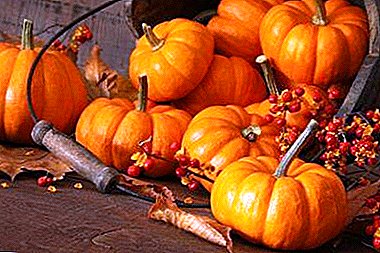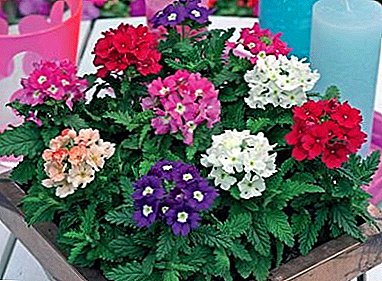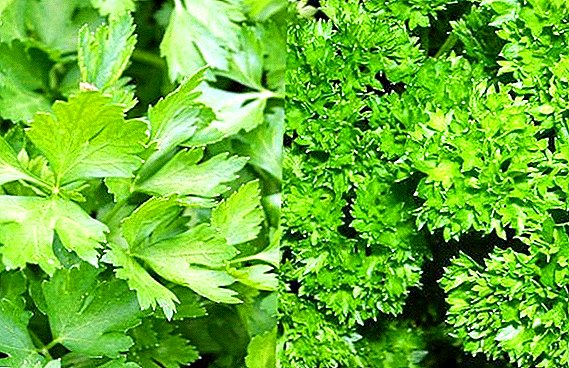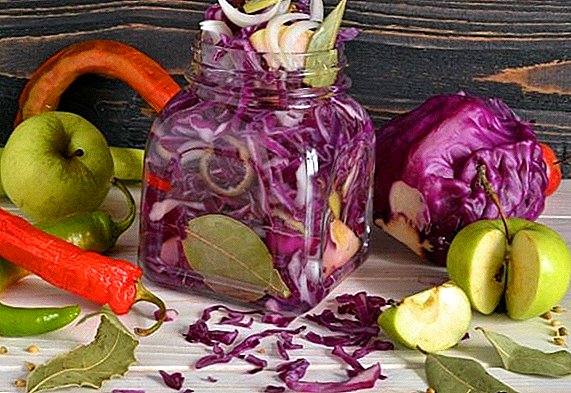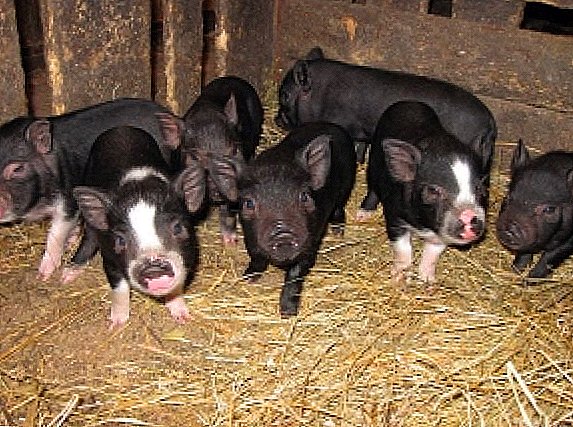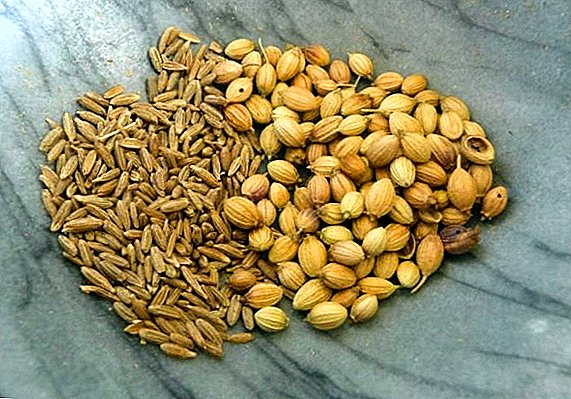 There is a large variety of spices that are actively used not only in cooking, but also in traditional medicine, which accounts for the increased interest in them. Many of them are similar to each other, so it is not surprising that there is often confusion with definitions. This article discusses the features of cumin and coriander, their differences and possible scope.
There is a large variety of spices that are actively used not only in cooking, but also in traditional medicine, which accounts for the increased interest in them. Many of them are similar to each other, so it is not surprising that there is often confusion with definitions. This article discusses the features of cumin and coriander, their differences and possible scope.
Cumin Description
Cumin - a perennial or biennial plant that has several species. The most famous of these are the common, black and brown varieties used in cooking as a fragrant spice. Their leaves are multi-feathery, the flowers are of both sexes, or partially staminate, flowering is in pink, red or white shades, depending on the particular species. Of particular value are oblong, slightly flattened fruits from the sides with blunt ribs. Inside them are seeds, the smell and taste of which resembles aniseed fruits. 
100 g of dried cumin seeds contains:
- 333 kcal;
- 26% (daily) protein;
- 17% fat;
- 17% carbohydrate.
In addition, they contain vitamins A, C, E, K, group B (B1-B4, B6, B9); macronutrients represented by potassium, calcium, magnesium, sodium, phosphorus; trace elements in the form of iron, zinc, selenium, copper.
Cumin and coriander plants look quite similar in appearance, so there is often confusion.
Did you know? Cumin was actively used by people during the time of the existence of the ancient Egyptian civilization (approximately 4000 years BC). However, some excavations of archaeologists confirm the even more ancient history of spices, because its seeds were discovered in the excavations of the Neolithic and Mesolithic, which are about 8000 years old.
However, there are differences between them, for example:
- Cumin blooms more abundant than coriander, so there are much more umbellate inflorescences;
- in the first case, the leaf plates are more elongated, while most of the coriander leaves are wide and resemble parsley;
- most cumin bushes will be higher than coriander bushes;
- cumin - a perennial or biennial plant, but coriander can be grown only for one year;
- in the first case, the fruits are oblong and narrow (somewhat reminiscent of a crescent moon), and in the second, they are oval and look more like small forest nuts;
- Cumin seed calorie content is higher than that of coriander.

Coriander Features
Ordinary sowing coriander is an annual plant of the same name of the Umbrella family. The above-ground green part is called cilantro, and the seeds are called coriander, and they are more often used in various fields of human activity: cooking, cosmetology, perfumery, and alternative medicine.
From a botanical point of view, this is a relatively low plant (up to 70 cm), with branching bushes closer to the top. Basal leaf plates - wide-blade, coarsely dissected, retaining on long petioles. In the middle and upper zone - they are sessile, pinnately dissected. During flowering (June - July or August - September), umbellate inflorescences are formed, with small marginal flowers usually white or pinkish, 3-4 mm long. Fruit with seeds has an ovoid-spherical shape, with straight and slightly wavy ribs.
Learn more about the composition and properties of coriander.
100 g of dried and ground seeds of a plant contain:
- 298 kcal;
- 17% (daily allowance) of protein;
- 20% fat;
- 18% carbohydrate.
In addition, it is worth noting the presence in the composition of such important components as:
- vitamins C, B1-B3;
- calcium;
- magnesium;
- phosphorus;
- iron;
- potassium;
- sodium;
- zinc;
- copper;
- manganese;
- selenium.
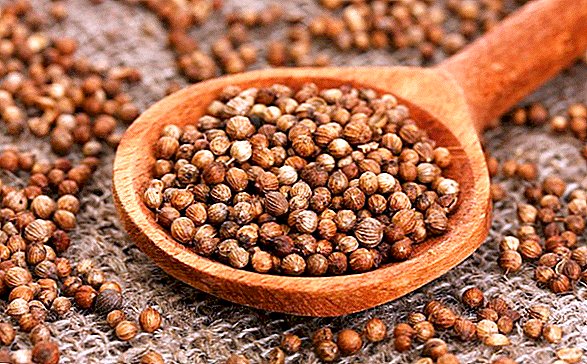
It is easy to notice that there are far fewer vitamins in coriander than in cumin, therefore this fact should be attributed to the above differences.
Otherwise, the distinctive characteristics remain the same:
- different structure of the leaves of two plants;
- uneven abundance of flowering;
- differences in the height of the bush and the shape of the fruit;
- the difference in caloric and chemical composition of coriander and cumin.
Did you know? Coriander is sometimes called "klopovnik", although it does not have any direct relation to insects. The fact is that during flowering the plant exudes a specific aroma, somewhat resembling the presence of these pests.
The origin of two plants
The properties of each of these plants have been formed for thousands of years and largely depended on the growing environment of cumin and coriander. Unfortunately, many of the data from the history of their origin has not been preserved to this day, but nevertheless there is some information on which to draw upon the preparation of a specific historical picture.
Coriander. The exact origin of the plant is unknown, but most likely its homeland is the territory of the Eastern Mediterranean. In Europe, coriander came in the I century AD. Oe. that many historians have associated with the Roman conquest (it is believed that the Romans brought the plant to the territory of modern Britain). Here it was grown for many centuries, before in the XV-XVII century (the era of geographical discoveries), the seeds fell to America, New Zealand and Australia.

Mention of coriander on Russian territory has been found in literature only since the 18th century, and the ancient name “Kishnitsa” may indicate that it was brought here from the East. The mass cultivation of culture in the central part of Russia was taken closer to the 30s of the XIX century, after which the inhabitants of the nearby territories paid attention to it. Today, coriander is grown almost everywhere, and where it is not planted on purpose, it grows wild (for example, in Central Asia and the Crimea).
Important! Despite the availability of cumin seeds in free sale, many people continue to collect them in the field. In such cases, you can never be sure of their high quality, but if you still decide to take the risk, choose only environmentally friendly places to collect, away from roads and industrial facilities.
Caraway. In the culture, this plant began to be grown before our era, presumably in the territory of Asia Minor. In addition, it is deservedly considered one of the oldest spices in Europe, where it was introduced to the culture in the IX century. In the modern world, plantations of cumin can be found in Hungary, Bulgaria, Denmark, Poland and other European countries, not to mention the cultivation in the northern part of the United States and the countries of the Middle or Middle East.
On the territory of Russia of the pre-revolutionary period, cumin seeds were often collected from wild-growing species, and in field conditions cumin seed experiments began in 1929 from the Rostov-Nihichivansky experimental station. In Ukraine, the main crops of cumin fall in western territories. 
Beneficial features
The chemical composition of cumin and coriander could not affect their useful properties, which later began to be used by humans for various purposes. The main characteristics of these spices differ significantly.
Cumin
The most visible healing properties of the plant are expressed in:
- stimulate the production of gastric juice;
- a decrease in the intensity of fermentation processes in the intestine and the relaxation of its muscles;
- normalization of the digestive system;
- breast milk production;
- diuretic and mild laxative effects;
- reduction of painful sensations during menstruation in women and flatulence in children;
- reduction of headaches, manifestations of intestinal disorders, stomach cramps and diseases of the gallbladder.
We advise you to learn more about the beneficial properties and application of cumin.
For cosmetic and perfumery purposes, cumin oil is widely used, which has a positive effect on the general condition and texture of the skin. Moreover, it is a natural antiseptic that promotes regenerative processes and even eliminates worms or other parasites in the human body. For prophylactic purposes, cumin oil is used to prevent tuberculosis, oncology and colds.
Coriander
If in the previous case the plant seed properties are more remarkable, then coriander leaves will also be useful for humans. Unlike seed products, they are used fresh to create salads, since this is the best way to preserve all the useful vitamins and minerals. 
The main positive properties of this culture include:
- bactericidal effect (due to this, the plant is often used in the treatment of problems of the oral cavity);
- strengthening the vascular walls;
- lower blood sugar levels;
- normalization of cholesterol levels;
- acceleration of digestion;
- normalization of the emotional state;
- acceleration of recovery processes in the gallbladder, liver;
- improving the taste properties of drugs;
- slight laxative effect;
- hemostatic properties.
Important! The daily consumption rate of coriander leaves is 35 g, and the seeds are no more than 4 g per adult and completely healthy person.
Application features
And cumin, and coriander has been used successfully in cooking, alternative medicine, cosmetology, and even perfumery; however, in each case it is necessary to take into account the specific features of the use of cultures.
In cooking
In cooking, cumin has found application mainly as a spicy addition to various dishes and preservation, however, it is not excluded the possibility of using not only the seeds, but also the roots or leaf plates, both in whole and in ground form. Freshly picked leaves are a healthy ingredient in salads and an excellent addition to meat and cheese delicacies.
Culture seeds are often used as a seasoning when cooking liquid dishes (soups, sauces), as well as an additive to meat and vegetables. In addition, often ground seeds of the described spices are added to marinades when pickling tomatoes or cucumbers, as well as sauerkraut. Most often, you can find cumin in bakery and confectionery products: cakes, pies, cakes, etc. Of the drinks, the most common uses for cumin are kvass and beer.
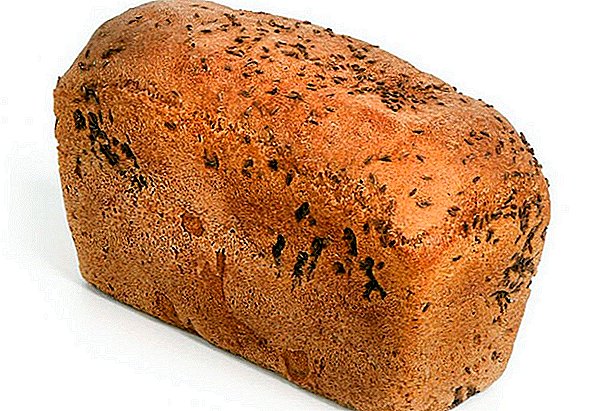
Coriander is used in the culinary industry in the form of fresh and dried herbs or seeds. The green part is used in salads, solyanka, fish and vegetable dishes, and also included in various sauces intended for fatty meats (for example, goulash, stewed or roast pork). Dried coriander herbs have a special value because it is characterized by a more pronounced aroma.
The taste of coriander seeds is significantly different from the taste characteristics of its greens (it has a weak lemon shade), but this only contributed to its use in canning the harvest and meat products: harvesting mushrooms, cabbage, tomatoes, creating fish, meat and cheese canned goods.
Important! If possible, you should buy whole coriander fruits and crush the seeds yourself before you use them directly. For better grinding, it is recommended to fry them a little in a dry frying pan (no longer than 1-2 minutes), and then cool.
Coriander significantly enhances the taste and aroma of beans (in particular, peas and lentils). In the production of bakery and confectionery products, spice plays the role of a flavoring agent and is most often found in the composition of sweet baking, cookies, gingerbread. Also seeds of culture are used in the sausage industry and serve as one of the main components of kvass and beer (especially in European countries).

In folk medicine
The use of cumin and coriander in traditional medicine is not as wide as in cooking, but there are plenty of opportunities in this area as well. For example, cumin is useful for coughing, inflammation of the lungs and bronchi, intestinal disorders and diseases of the gallbladder. In addition, the seeds of this plant improve appetite and optimize all digestive processes, especially with atony and painful manifestations in the stomach.
The seeds of the crop are often included in the herbal collections of laxative and soothing effects, as well as infusion they are useful for women during the breastfeeding period of the child, since they contribute to the better formation of milk. In the decoction of the grass from this plant, children are often bathed.
Did you know that cilantro and coriander are one plant, but different names?
Coriander seeds are often used to make decoctions and infusions that help to cure nervous disorders and diseases of the digestive system. In addition, the decoction of the grains is recommended to use for cystitis, hemorrhoids, flatulence and even some dermatological problems.
Equally important is the positive effect of coriander seeds on the cardiovascular system and brain activity, and even with their help you can eliminate the unpleasant smell of alcohol and get rid of hangover. However, in order to extract the maximum benefit from the plant, it is worthwhile to use not the seeds themselves, but the oil based on them.

In cosmetology
Both caraway and coriander are used for cosmetic purposes, mainly in the form of essential oils that can be added to existing cosmetics (creams, lotions, scrubs, gels or shampoos), or supplemented with other useful oils and make a completely new skin care product and hair When self-creating masks and nourishing creams, in addition to the oily base, you can use cream, egg, oatmeal flour and even cottage cheese, on the basis of which the finished compositions can be used to soften the skin of the face, and to remove acne or pigment spots.
On the basis of thyme oil, they often prepare a refreshing lotion that helps to remove swelling, swelling and improve the overall appearance of the face. A few milliliters of such oil in shampoo will help strengthen the hair, make it shiny and silky. A mixture of caraway and olive oils, added to the store mask for hair, perfectly helps in the fight against peeling and dandruff.
Important! When using any kind of essential oils, always carefully monitor the dosage, since contact with the skin of a large amount of such a product may cause burns or irritation on its surface.
Possible contraindications and harm
In case of violation of the permissible dosage or ignoring the rules of use and consumption of cumin or coriander, unwanted side effects are possible, which are most often expressed in:
- allergic reactions (rash or itching, choking coughing attacks);
- aggravation of existing health problems (for example, the exit of stones with urolithiasis);
- diarrhea, flatulence.
In healthy people, such phenomena are extremely rare, but if there are problems initially, then you should not be surprised at such violations.
The main contraindications to the use of cumin and coriander include:
- individual sensitivity to these plants;
- serious problems of the gastrointestinal tract (ulcer, gastritis), especially in the period of exacerbation;
- urolithiasis and the presence of stones in the kidneys or gallbladder;
- the presence of transplanted organs, but mostly in the first time after transplantation, when the risk of rejection by the body of foreign tissues is especially great;
- period after a stroke or heart attack, any surgical intervention.

In some cases, these contraindications are stricter, in others they allow an exception to the rules, but in order not to harm your health, it is better to be safe and once again refuse specific spices and dishes.
If a person is healthy, there should be no negative consequences from eating cumin or coriander. On the contrary, the appropriateness and metered use of these products can significantly improve the state of health, at the same time enhancing the protective functions of the body and having a beneficial effect on the condition of the skin.





